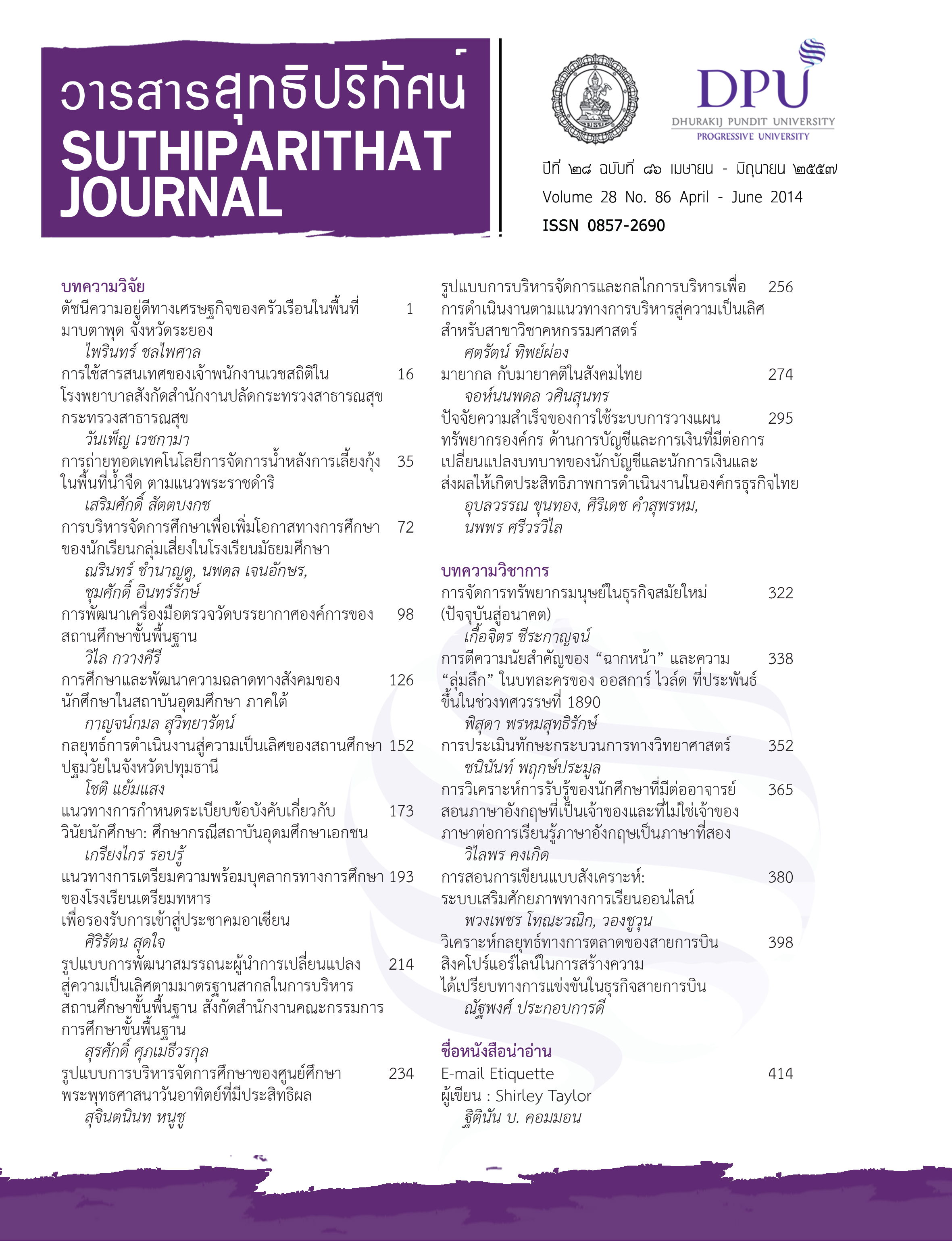การสอนการเขียนแบบสังเคราะห์: ระบบเสริมศักยภาพทางการเรียนออนไลน์
คำสำคัญ:
การสอนการเขียน, การส่งเสริมศักยภาพผู้เรียนออนไลน์, วิธีการสอนการเขียน, การเรียนรู้ด้วยตนเอง, การพัฒนาทักษะการเขียนบทคัดย่อ
บทความนี้นำเสนอรูปแบบการสอนการเขียนด้วยระบบเสริมศักยภาพทางการเรียนออนไลน์ สำหรับผู้เรียนภาษาอังกฤษเป็นภาษาที่สอง เพื่อให้ผู้สนใจนำไปทดลองใช้จริงในชั้นเรียนว่ารูปแบบนี้ช่วยผู้เรียนให้สามารถเขียนย่อหน้าหรือเรียงความและพัฒนาคุณภาพของงานเขียนได้ด้วยตัวเองหรือไม่ วิธีการสอนการเขียนที่นิยมใช้กันทั่วไปนั้นมีข้อดีและข้อด้อยของแต่ละวิธี การใช้เฉพาะวิธีใดวิธีหนึ่งจึงอาจทำให้การเรียนการสอนในวิชาการเขียนไม่เกิดประสิทธิภาพอย่างเต็มที่ได้ ดังนั้นรูปแบบการสอนการเขียนด้วยระบบเสริมศักยภาพทางการเรียนออนไลน์ จึงเป็นการรวมเอาข้อดีของวิธีสอนที่ได้รับความนิยมสาม วิธีไว้ด้วยกันคือ การสอนที่เน้นผลงานเขียน (product) การสอนที่เน้นขั้นตอนการเขียน (process) และ การสอนที่เน้นรูปแบบการเขียนประเภทต่างๆ (Genre-oriented) และเพิ่มเทคนิคที่เป็นการช่วยผู้เรียนมากขึ้น กล่าวคือ รูปแบบนี้กำหนดให้ผู้เรียนเขียนความเรียงที่มีความยาวหลายๆย่อหน้า โดยจะเรียนรู้กระบวนการเขียน เช่น ขั้นตอนก่อนลงมือเขียน การร่าง การรับฟังข้อเสนอแนะและการปรับปรุงงานเขียนขั้นตอนสุดท้ายด้วยตนเอง ประการที่สอง รูปแบบนี้ประยุกต์ใช้แนวคิดการเสริมศักยภาพผู้เรียน (Scaffolding) เพื่อให้ความช่วยเหลือผู้เรียนในทุกขั้นตอนของการเขียน นอกจากนี้วิธีนี้ยังช่วยส่งเสริมและฝึกให้ผู้เรียนใช้อินเทอร์เน็ตในการสืบค้นข้อมูลที่เกี่ยวข้องกับหัวข้อที่จะเขียนเพื่อให้ความคิด กว้างขวางและประการสำคัญคือช่วยเพิ่มศักยภาพการใช้ภาษา เพราะนอกจากส่งเสริมการใช้พจนานุกรมต่างๆออนไลน์แล้วรูปแบบการสอนนี้ฝึกให้ผู้เรียนตรวจสอบและศึกษาการใช้ภาษาอย่างถูกต้องและมั่นใจ จากเว็บไซต์คอร์ปอร่าออนไลน์ (Online Corpora) ขณะเดียวกันยังคงได้รับคำแนะนำ (Feedback) จากอาจารย์ผู้สอนอีกทางหนึ่ง การสอนให้นักศึกษาใช้คอร์ปอร่าออนไลน์เป็นการลดภาระผู้สอนในชั้นเรียน และส่งเสริมให้ผู้เรียนสามารถเรียนรู้ด้วยตนเองตลอดชีพ
References
Andrews, R., Torgerson, C., Low, G., & McGuinn, N. (2009). Teaching argument writing to 7-to 14-year-olds: an international review of the evidence of successful practice. Cambridge Journal of Education, 39(3), 291-310.
Badger, R., & White, G. (2000). A process genre approach to teaching writing. ELT Journal, 54(2), 153-160.
Beck, A. T., & Alford, B. A. (2009). Depression: Causes and treatments. Pennsylvania: University of Pennsylvania Press.
Bernardini, S. (2001). Spoilt for choice’: A learner explores general language corpora. Learning with Corpora. Italy: University of Bologna. pp. 220-249.
Biber, D. (2001). Using corpus-based methods to investigate grammar and use: Some case studies on the use of verbs in English. In R. Simpson and J. Swales (eds.), Corpus linguistics in North America, 101-115. Michigan: University of Michigan Press.
Bizzell, P. (1982). Cognition, convention, and certainty: What we need to know about writing. Pre/text, 3(3), 213-243.
Chow, T. V. F. (2007). The Effects of The Process-Genre Approach To Writing Instruction On The Expository Essays Of ESL Students In A Malaysian Secondary School. Penang: Universiti Sains Malaysia.
Cotterall, S., & Cohen, R. (2003). Scaffolding for second language writers: producing an academic essay. ELT Journal, 57(2), 158-166.
Gilmore, A. (2008). Using online corpora to develop students’ writing skills. ELT Journal, 63(4), 363-372.
Goldberg, A., Russell, M., & Cook, A. (2003). The effect of computers on student writing: A meta-analysis of studies from 1992 to 2002. The Journal of Technology, Learning and Assessment, 2(1). Retrieved November 12, 2012, from http://www.jtla.org.
Grabe, W., & Kaplan, R. B. (1997). On the writing of science and the science of writing: Hedging in science text and elsewhere. In R. Markkanen & H. Schroder (Eds.), Hedging and Discourse Approaches to the Analysis of Pragmatic Phenomenon in Academic texts. pp.151-167. Berlin: Walter de Gruyter & Co.
Guan, Z. Y. (2009). The rationale and implemantation for designing the multi-media teaching materials of learning Chinese as a second language. (6 ed.). International Conference on Internet Chinese Education.
Hassan, F., & Selamat, N. F. (2002). Why aren’t students proficient in ESL: The teachers’ perspective. The English Teacher, 28. Retrieved June 20, 2011, From http://www.melta.org.my/ET/2002/wp10.htm
Hasselgard, H. (2001). Corpora and their use in research and teaching. Retrieved November 2, 2012, from: http:// folk.uio.no/hhasselg/UV-corpus.htm.
Hedge, T. (1998). Writing Resource Book for Teachers: Oxford: Oxford University Press.
Hicks, D. (1997). Working Through Discourse Genres in School. Research in the Teaching of English, 3 1(4), 459-485.
Holliday, M. (1992). Linguistics Studies of Text and Discourse. New York: Continuum International Publishing Group.
Horowitz, F., Darling-Hammond, L., Bransford, J., Comer, J., Rosebrock, K., Austin, K., & Rust, F. (2005). Educating teachers for developmentally appropriate practice. Preparing teachers for a changing world: What teachers should learn and be able to do, pp. 88-125.
Jabbour, G. (2001). Lexis and grammar in second language reading and writing. Linking literacies’ Perspectives on L 2 reading-writing connections, pp. 291-308.
Johns, T. (1991). Should you be persuaded: Two samples of data-driven learning materials. English language research journal, 4, 1-16.
Kim, Y., & Kim, J. (2005). Teaching Korean University Writing Class: Balancing the Process and the Genre Approach. Asian EFL Journal, 7(2), 69-90
Kryszewska, Hania, & Davis, Paul. (2012). The company words keep. London. Retrieved March 14, 2013, from http://goo.gl/EYp9B)
Lin, B. (2006). Genre-based teaching and Vygotskian principles in EFL: The case of a university writing course. The Asian EFL Journal Quarterly. 8(3), 226-248.
Muncie, J. (2002). Finding a place for grammar in EFL composition classes. ELT Journal, 56(2), 180-186.
Nunan, David. (2001). Second English Teaching and Learning. Beijing: Foreign Language Teaching and Research Press.
Pennington, M. C. (1993). Exploring the potential of word processing for non-native writers. Computers and the Humanities, 27(3), 149-163.
Pennington, M. C. (1995). The teacher change cycle. Tesol Quarterly, 29(4), 705-731.
Pennington, M. C. (1996). When input becomes intake: Tracing the sources of teachers’ attitude change. In D. Freeman, & J. C. Richards (Eds.), Teacher learning in language teaching pp. 320-348 New York: Cambridge University Press.
Pincas, A. (1982). Teaching English Writing: Essential Language Teaching Series London: Macmillan.
Reppen, R. (2010). Using corpora in the language classroom. Cambridge: Cambridge University Press.
Santrock, J. W. (2008). Essentials of Life-span Development: Preview Guide. New York: McGraw Hill Higher Education.
Schmitt, Norbert, & Celce-Murcia, Marianne. (2010). An overview of applied linguistics. In Norbert Schmtt (ed.), An introduction to applied linguistics. (2nd ed). London: Arnold Publishers. pp. 1-15.
Schwartz, H. J. (1982). Monsters and mentors: Computer applications for humanistic education. College English, 44(2), 141-152.
Selber, S. A. (2005). Postcritical Perspectives on Literacy Technologies. College English. 67(3), Retrieved October 18, 2012, From http://www.jstor.org/stable/3004464
Stevens, V. (1995). Concordancing with language learners: why? when? what. CAELL Journal, 6(2), 2-10.
Sun, C., & Feng, G. (2009). Process approach to teaching writing applied in different teaching models. English Language Teaching, 2(1), 150.
Varghese, S. A., & Abraham, S. A. (1998). Undergraduates arguing a case. Journal of second language writing, 7(3), 287-306.
Wepner, S. B., Valmont, W. J., & Thurlow, R. (2000). Linking Literacy and Technology: A Guide for K-8 Classrooms. Newark: International Reading Association.
White, R., & Arndt, V. (1991). Process writing. London: Longman.
Wood, D., & Wood, H. (1996). Vygotsky, tutoring and learning. Oxford Review of Education, 22(1), 5–16.
Yelland, N., & Masters, J. (2007). Rethinking scaffolding in the information age. Computers & Education, 48(3), 362-382.
Yoon, H. (2008). More than a linguistic reference: The influence of corpus technology on L2 academic writing. Language Learning & Technology, 12(2), 31-48.
Yoon, H., & Hirvela, A. (2004). ESL student attitudes toward corpus use in L2 writing. Journal of second language writing, 13(4), 257-283.
Downloads
เผยแพร่แล้ว
How to Cite
ฉบับ
บท
License
เนื้อหาและข้อมูลในบทความที่ลงตีพิมพ์ในวารสารสุทธิปริทัศน์ ถือเป็นข้อคิดเห็นและความรับผิดชอบของผู้เขียนบทความโดยตรงซึ่งกองบรรณาธิการวารสาร ไม่จำเป็นต้องเห็นด้วย หรือร่วมรับผิดชอบใดๆ
บทความ ข้อมูล เนื้อหา รูปภาพ ฯลฯ ที่ได้รับการตีพิมพ์ในวารสารสุทธิปริทัศน์ ถือเป็นลิขสิทธิ์ของวารสารสุทธิปริทัศน์หากบุคคลหรือหน่วยงานใดต้องการนำทั้งหมดหรือส่วนหนึ่งส่วนใดไปเผยแพร่ต่อหรือเพื่อกระทำการใด ๆ จะต้องได้รับอนุญาตเป็นลายลักษณ์อักษรจากวารสารสุทธิปริทัศน์ก่อนเท่านั้น






